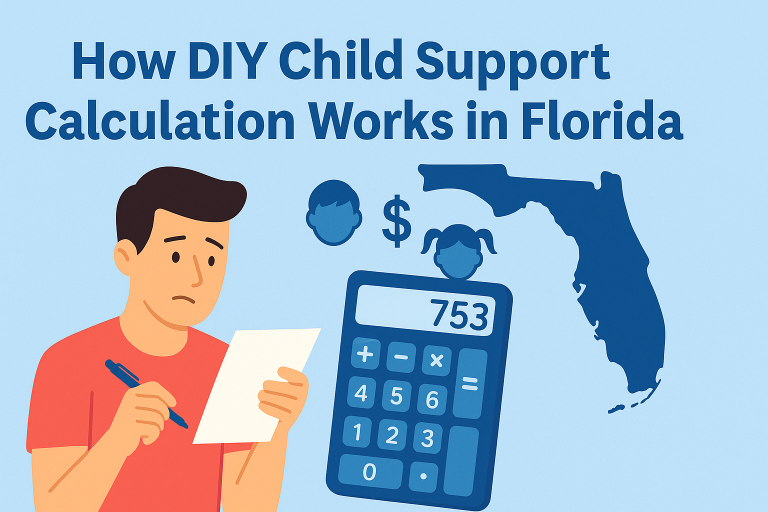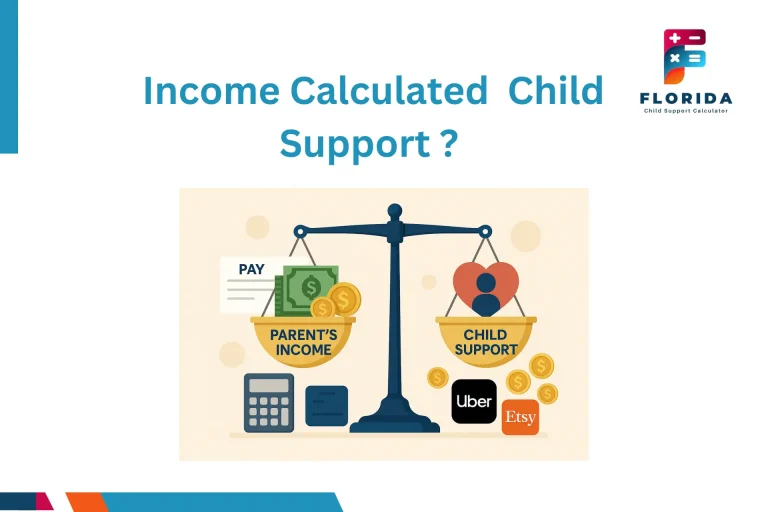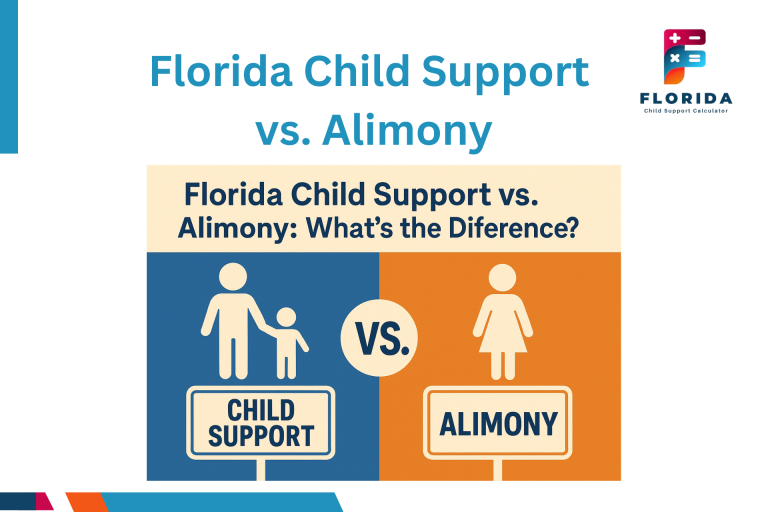Florida Child Support Calculator vs. DIY Math: Which Is Better?
Florida Child Support Calculator vs DIY Math is like asking: should you use a GPS or just “wing it” with road signs? If you’re figuring out child support in Florida, both options exist, but one might save you from wrong turns. The Florida child support calculator is designed to be fast and fair, especially when time-sharing and income levels come into play.

On the other hand, some parents still choose to do it themselves using Florida’s support guidelines. That’s not always a bad thing, but it can get tricky. By the end of this article, you’ll know exactly which method suits you best and when it’s smarter to stick to the court-friendly route.
What Is the Florida Child Support Calculator and Why Do People Trust It?
When parents split up in Florida, figuring out child support can feel like solving a puzzle. That’s why the Florida child support calculator is so helpful, it’s a tool made to make things simple and fair.
It uses numbers like your income, how many kids you have, and how often they stay overnight. Once you put this info in, it shows you what support amount the law might expect. This makes things easier for both parents and helps courts in Florida keep things fair for the child.
People trust it because it’s based on real estate rules, not guesses. If you’re trying to avoid mistakes or arguments, this is where many families start.
How DIY Child Support Calculation Works in Florida
Some parents like doing the math themselves. It’s called “DIY,” short for “Do It Yourself.” In Florida, you can use state guidelines to figure things out by hand.

But it’s not just regular math. You need to know your gross monthly income, subtract things like daycare or health insurance, and then apply the Florida child support guidelines chart. That chart shows you the base amount depending on income and the number of kids.
Doing this yourself can feel like cooking without a recipe; some parents get it right, others don’t. That’s why it’s important to double-check with tools or talk to a lawyer if anything feels off.
Manual Formula Breakdown
Florida uses a fixed formula. First, add up both parents’ gross monthly income. Then, check the chart to find the basic support amount. After that, divide the amount based on each parent’s income and calculate the share and time-sharing with the child.
You can see this in action using real numbers or even fill out the child support worksheet provided by the state.
Here’s a quick example: If one parent earns $3,000 and the other earns $2,000, the total is $5,000. If the chart says $800 is owed for one child, the first parent pays 60% of that. Sounds simple? It gets tricky fast!
Common Mistakes People Make
DIY child support may seem easy, but small mistakes can cause big trouble. Some parents forget to include bonuses or second jobs. Others skip adding health or school costs.
Sometimes, people don’t realize that parenting time affects support, especially in shared custody cases. Or they use net income instead of gross, which throws off the whole amount.
A wrong number can lead to legal issues or denied modifications later. So even if you like doing math, it’s smart to double-check.
Florida Child Support Calculator vs DIY Math: Quick Comparison Table
Choosing between the calculator and doing math yourself can be tough. That’s why it helps to compare both sides by side, so you can see what fits best.

| Factor | Calculator Method | DIY Math Approach |
|---|---|---|
| Accuracy | High follows Florida’s support laws exactly | It can be off if you miss income or custody details |
| Ease of Use | Very simple, just enter numbers | Complex – need to know the full Florida child support formula |
| Court-Friendly | Preferred in legal cases | Might need extra proof or review |
| Risk of Mistakes | Low – built to prevent human errors | High, especially if time-sharing or deductions are missed |
This table helps you see why most people in Florida stick to the calculator, but we’ll still look at both sides fairly.
Pros and Cons of Each Method
Both options, using the calculator or going full DIY, have pros and cons. Let’s break them down so you can decide what works for your family.

Calculator Pros & Cons
Using the Florida child support calculator is like riding a bike with training wheels, it’s steady, smooth, and safer for most.
Pros:
- It’s fast and easy
- You won’t forget key income or custody rules
- It matches court expectations and forms
Cons:
- It doesn’t always allow for special cases
- You still have to enter things like insurance or daycare, which some parents guess wrong
Even though it has limits, most Florida families prefer this method for peace of mind.
DIY Method Pros & Cons
Doing child support math yourself can feel like baking without measuring cups. It might work, or it might flop.
Pros:
- You understand every number yourself
- You can tweak the formula to fit real-life costs
Cons:
- Easy to mess up time-sharing math
- Courts may not accept your numbers if you don’t follow the Florida support chart
- Some forget to include extra income, like side jobs or bonuses
If you’re confident and detail-focused, DIY might work. But if you’re unsure, it’s better to double-check with a calculator or legal help.
How Parenting Time Affects Child Support in Florida
Even if both parents make the same income, parenting time changes everything. Florida uses an overnight count to adjust support, more overnights usually mean less money paid.
That’s why using the parenting time calculator helps many families plan better. Missing even a few nights can swing the support amount by a lot.
Parents who guess or forget to count nights properly often end up with unfair numbers. That’s why courts rely on accurate time-sharing input in the official calculator.
When to Use the Calculator, When to DIY
This is where it gets personal. There’s no one-size-fits-all answer, it depends on your case.

If both parents agree on income and custody time, then the online calculator is the best tool. It works well for shared parenting plans and helps you avoid courtroom confusion.
But in tricky cases, like if one parent is self-employed or if income varies, DIY math might feel more accurate. Just be sure you follow the official Florida income rules, or it may not hold up in court.
In any case, whether you’re filling out a parenting plan or adjusting support later, make sure your math is clean, clear, and court-ready.
Modifying Child Support in Florida: Can You Switch Between Methods?
Sometimes, families need to update child support. This could be because of a job loss, a new custody plan, or rising costs.
You can request a child support modification from the court. Whether your numbers came from a calculator or DIY math, Florida will still look at the current situation.
Some parents start with DIY math, then switch to the calculator during modifications to avoid errors. As long as the data is correct, either method can be used, but courts lean toward calculator results for consistency.
What Florida Lawyers Recommend (And Why It Matters)
When things get serious, people ask lawyers for help. And most Florida lawyers suggest using the official calculator, especially in cases that involve custody time or shared parenting.

They say the calculator keeps things clean, follows Florida child support law, and is easier to defend in court. That’s super important if there’s a disagreement between parents.
Still, some lawyers understand that manual math can help when income is unusual, like when one parent works freelance or has business income. In short, lawyers like the calculator, but they know one size doesn’t fit all.
FAQs About Florida Child Support Estimations
Let’s answer some common questions parents ask when trying to choose between a calculator and DIY math.
Final Thoughts: What Should You Use for Florida Child Support?
Now that you’ve seen both sides, which one is right for you? If you want a fast, fair, and court-friendly answer, go with the Florida child support calculator.
But if your case has twists, like lots of expenses or a custom custody setup, DIY math might help you fine-tune. Just don’t forget to cross-check with the income table or have a lawyer review your numbers.
In the end, child support isn’t about who’s right. It’s about what’s fair for your kid. That’s the real win.






